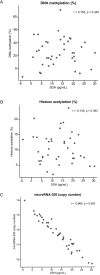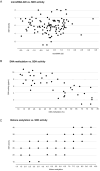Epigenetic Regulation of Sorbitol Dehydrogenase in Diabetic Retinopathy Patients: DNA Methylation, Histone Acetylation and microRNA-320
- PMID: 40321666
- PMCID: PMC12048750
- DOI: 10.2147/BTT.S521519
Epigenetic Regulation of Sorbitol Dehydrogenase in Diabetic Retinopathy Patients: DNA Methylation, Histone Acetylation and microRNA-320
Abstract
Purpose: This study aimed to investigate the correlation between epigenetic markers and sorbitol dehydrogenase (SDH) levels in patients with type 2 diabetes and diabetic retinopathy (DR).
Patients and methods: We conducted a case control study on 40 patients with type 2 diabetes and DR and 40 patients with type 2 diabetes without DR. Clinical data and ophthalmological examinations were performed to confirm the presence or absence of DR. Blood samples were collected for the analysis of DNA methylation, histone acetylation, microRNA-320 levels, and SDH enzyme activity. The epigenetic markers were evaluated using enzyme linked immunosorbent modified assay. The data were analyzed using statistical tests, including Spearman correlation and multiple linear regression.
Results: In patients with DR, there was a significant negative correlation between microRNA-320 levels and SDH enzyme activity (r=-0.968, p=0.000). No significant correlations were found between DNA methylation or histone acetylation and SDH activity. Multivariate analysis confirmed the strong negative correlation between microRNA-320 and SDH (r = -0.727, p=0.000), with microRNA-320 explaining 58.1% of the variance in SDH levels.
Conclusion: The findings suggest that microRNA-320 plays a crucial role in regulating SDH enzyme activity in patients with type 2 diabetes and DR. The development of microRNA-320-based therapies, such as miRNA mimics or antagomirs, may offer a novel approach to modulating SDH activity and mitigating the detrimental effects of the polyol pathway in DR. Further researches are needed to validate the results and mechanism underlying the correlation between epigenetic regulation SDH in DR.
Keywords: case control studies; genetic; linear models; microRNAs; type 2 diabetes mellitus.
© 2025 Amin et al.
Conflict of interest statement
The authors report no conflicts of interest in this work.
Figures


Similar articles
-
Association study of sorbitol dehydrogenase -888G>C polymorphism with type 2 diabetic retinopathy in Caucasian-Brazilians.Exp Eye Res. 2013 Oct;115:140-3. doi: 10.1016/j.exer.2013.06.027. Epub 2013 Jul 11. Exp Eye Res. 2013. PMID: 23850972
-
Association between sorbitol dehydrogenase gene polymorphisms and type 2 diabetic retinopathy.Exp Eye Res. 2008 Apr;86(4):647-52. doi: 10.1016/j.exer.2008.01.009. Epub 2008 Jan 14. Exp Eye Res. 2008. PMID: 18289528
-
Polymorphisms of sorbitol dehydrogenase (SDH) gene and susceptibility to diabetic retinopathy.Med Hypotheses. 2003 Apr;60(4):550-1. doi: 10.1016/s0306-9877(03)00013-6. Med Hypotheses. 2003. PMID: 12615520
-
Role of histone modification and DNA methylation in signaling pathways involved in diabetic retinopathy.J Cell Physiol. 2019 Jun;234(6):7839-7846. doi: 10.1002/jcp.27844. Epub 2018 Dec 4. J Cell Physiol. 2019. PMID: 30515789 Review.
-
Noncoding RNAs involved in DNA methylation and histone methylation, and acetylation in diabetic vascular complications.Pharmacol Res. 2021 Aug;170:105520. doi: 10.1016/j.phrs.2021.105520. Epub 2021 Feb 25. Pharmacol Res. 2021. PMID: 33639232 Review.
References
LinkOut - more resources
Full Text Sources

